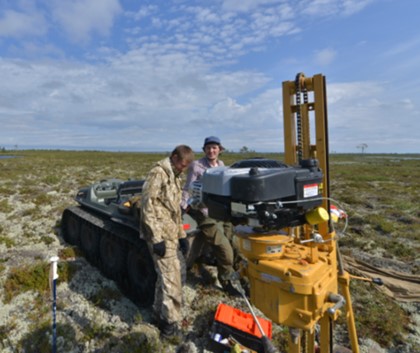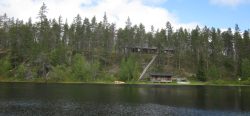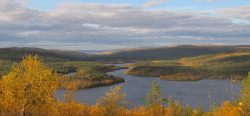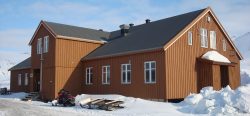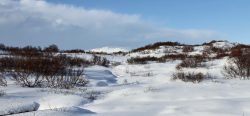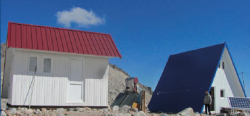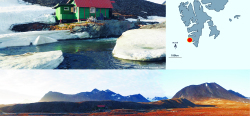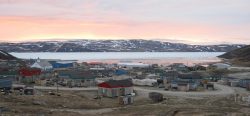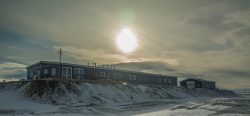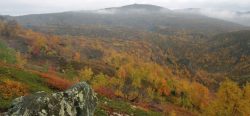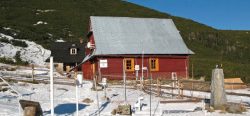Collaborator in the project until spring 2022
STATION NAME AND OWNER
The Khanymei Research Station belongs to the National Research Tomsk State University, Russia.
LOCATION
The Station is located south-east or Yamal-Nenets Autonomous District, at the northern taigaBoreal forest, a nearly continuous belt of coniferous trees across North America and Eurasia. Taiga is dense forest with many fallen trees and marshy soil. The term derives form the southern Siberian Turkic-Mongol... More of western Siberia in Russia at N63°43’19,73” E75°57’47,91” . Research sites are located in the flat hilly peatlandPeat is a soil type formed from slowly decomposing vegetation. It is found in wet areas where the lack of oxygen slows the breakdown of plant matter. Peatlands are areas... More (Palsas), having a little peatPeat is a soil type formed from slowly decomposing vegetation. It is found in wet areas where the lack of oxygen slows the breakdown of plant matter. Peatlands are areas... More deposits 0,5-1,5 m (rarely – up to 3 m), which is confined to discontinuous permafrostPermafrost is frozen ground that remains at or below zero degrees Celsius (32 degrees Fahrenheit) for two or more years. It forms in regions where the mean annual temperature is... More. As a result of the active thermokarstA landform that results when ground ice (ice-rich permafrost) melts. The melting leaves small, marshy hollows and hummocks in the land as the ground settles unevenly. See also thermokarst lake.... More, accompanied by the general uplift of the grounds, its hydrological activity is strongly expressed, a lot of water bodies are generated.
BIODIVERSITY
The area is located in the northern taigaBoreal forest, a nearly continuous belt of coniferous trees across North America and Eurasia. Taiga is dense forest with many fallen trees and marshy soil. The term derives form the southern Siberian Turkic-Mongol... More of West Siberia. Upland areas covered with pine and larch forests, occupy higher-drained areas of the territory. In river valleys grow coniferousCone-bearing, as in coniferous trees such as pines and firs.... More forests. Research areas are located on the territory of peatlands Palsas, having a little peatPeat is a soil type formed from slowly decomposing vegetation. It is found in wet areas where the lack of oxygen slows the breakdown of plant matter. Peatlands are areas... More deposits 0,5-1,5 m (rarely – up to 3 m)and with separated areas of permafrostPermafrost is frozen ground that remains at or below zero degrees Celsius (32 degrees Fahrenheit) for two or more years. It forms in regions where the mean annual temperature is... More. A lots of lake are “scattered” on the surface of the peatPeat is a soil type formed from slowly decomposing vegetation. It is found in wet areas where the lack of oxygen slows the breakdown of plant matter. Peatlands are areas... More bogs. Lichens are usually occupy 70-80% of the ground surface.
The faunaThe animals that live in a particular region, habitat or time (such as geological period like the jurassic). For plants, we use the term flora, and to collectively refer to all... More is diverse. From the large mammals the following species should be note: the brown bear, lynx, moose, caribou, wolf, sable, fox, ermine, hare. Most of the avifauna is represented by migratory birds of aquatic and semi-aquatic habitats: swans, geese, goose, ducks, sandpipers, gulls. Pyakupur River River refers to the waters of the highest category, and contains ide, pike, burbot, perch, dace, roach, ruff, peled, whitefish, humpback whitefish, white salmon.
HISTORY AND FACILITIES
The Station is newly equipped and open for international visitors. The first international projects started to implement in the station region in 2014. The main accommodation area hosts 10 people.The station is equipped by meteorological complex, by sensors and logger of the soil and grounds temperature (including permafrostPermafrost is frozen ground that remains at or below zero degrees Celsius (32 degrees Fahrenheit) for two or more years. It forms in regions where the mean annual temperature is... More), by sensors for the levels of surface and underground water, by sensors for the power of the snow cover. A mobile station and laboratory section consists of a living-wagon for 8 people, mobile laboratory equipped with modern analytical, microbiological and refrigeration outfit, and special instrumentation for sampling. Off-road vehicles are also available.
GENERAL RESEARCH AND DATABASES
The research at Khanymey Station focuses on hydrologyThe study of water in the environment, particularly its amount, movement and quality. It encompasses water in rivers, lakes, glaciers, soil and underground aquifers. The way in which water (liquid and... More, meteorologyThe scientific study of the atmosphere and its phenomena, especially in relation to weather and weather forecasting.... More, ecologyThe study of living organisms in their environment, including where they are found and how they interact with their physical environment and with each other, for example through food webs.... More, botany, zoology, and soil science (primary productivity and mineralization of organic matter). Research topics include: climateThe average weather we would expect over a long period of time (seasons, years, decades). Climate varies from place-to-place across the Earth. Climate is determined by long-term (over at least... More impact on the biotic cycle of carbon and accompanying elements in the Palsa peatlands; migration of water-soluble substances from the catchment ecosystems to the water bodies; hydrochemical, hydrobiological and microbiological characteristics of the surface waters; biogeochemical function of microorganisms; optimizing productivity; ornithology and faunaThe animals that live in a particular region, habitat or time (such as geological period like the jurassic). For plants, we use the term flora, and to collectively refer to all... More studies. Geo-information analysis system is currently being developed for collection, analyze and store information on geochemically conjugated landscapes, geochemical characteristics of surface and bog waters, bottom sediments, and peats.
HUMAN DIMENSION
Nenets is a 6.3% of the population of the Pur region, Yamal-Nenets Autonomous District. The main occupations of the indigenousBelonging to a certain place. Indigenous people are distinct ethnic groups that have historic connections to people who lived in a territory prior to the area being colonized or coming... More inhabitants are herding, farming, fishing and harvesting of wild plants. Deer farms determines the life of the Nenets, and especially nomadism, closely connected with the biological habits of wild reindeer, which in summer moved to the coast of the sea, and in the winter – closer to the forest. Such movement of deers affected the nomadic Nenets, whose amplitude reaches five hundred kilometers. In the XX cen. the main part of them became settled. The history of the village Khanymej began in the second half of the 20th century with the construction of the railway Surgut-Urengoy. The main population of the village – Russians.
ACCESS
The station is located in the south-east of the Yamal-Nenets Autonomous District, Siberia, Russia and consists of two clusters. The main base is located on the watershed of Vengapur Pyakupur River, 70 km north of the Noyabrsk and 20 km north-east of the village Khanymey, Pur district; distant point is located on the main watershed between the rivers Nadym-Pur, in the North-Komsomolsk field. The nearest airport is in Noyabrsk, every day airport takes 1-2 flights from Moscow (journey time: 3 hours 25 minutes). Distance Noyabrsk Khanymey is 70 km by car.
